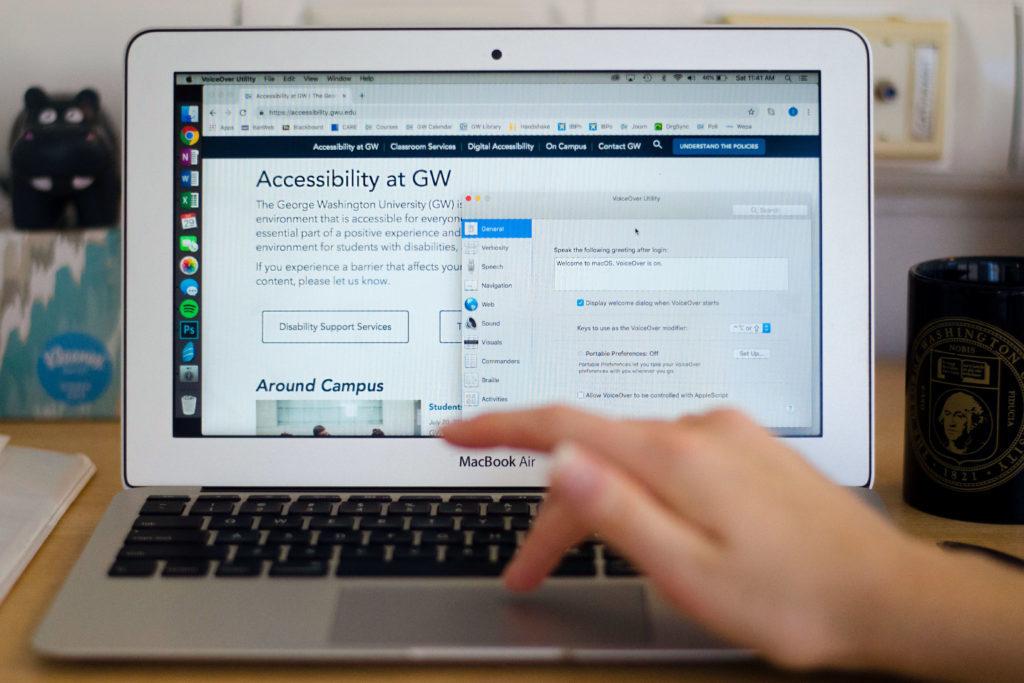The education department pushed back GW’s first federal deadline to ensure all new online content is accessible for individuals with disabilities.
The University signed a resolution agreement in March requiring officials to implement a plan by Oct. 1 to improve online accessibility after an investigation found GW was inaccessible for individuals with visual impairments. GW and the Department of Education agreed to shift the deadline to Jan. 15 to establish a plan to make all new online content accessible – including developing training for staff members, officials said.
University spokeswoman Lindsay Hamilton said the University is continuing to develop a “thorough” plan to ensure new online content is accessible to individuals with disabilities. She said the University and the Department of Education’s Office for Civil Rights agreed to an updated deadline but did not specify when the deadline changed.
Hamilton said GW is committed to providing an inclusive and “accessible environment” including the University’s websites and digital content.
“The University has a very large online presence and the technology that powers it is constantly evolving, thus monitoring and addressing accessibility issues is an ongoing effort,” she said in an email.
Hamilton declined to say what the new plan will look like and if it will be available to the public. She also declined to say who is involved in crafting the plan, how the plan will include staff training and what the training will include.
Hamilton declined to say when the staff training will be implemented and how training will make officials more aware of online disability compliance. She also declined to say how much it will cost to implement the changes and what additional resources will be required to make these changes.
The University fell under federal investigation in April 2017 for website navigation issues, like a lack of captions for images and videos, for individuals with disabilities. GW was one of more than 2,000 elementary, secondary and post-secondary schools facing federal disability investigations in January.
Officials from the Office for Civil Rights found that several GW web pages – including the University’s homepage and Facebook page – lacked captions, proper formatting and the ability to access content without a mouse. OCR mandated that GW develop a notice directing individuals to request that web content is made accessible and create a process to ensure that inaccessible content will be made accessible in an “expedient manner” by April 1, 2020.
Disability experts said that while it’s not uncommon for OCR to push a university’s deadline for a resolution agreement, it could mean GW is making progress on the goal but lacked resources or staffing that could not be secured in five months.
Dan Comden, the access technology center manager at the University of Washington, said developing a plan to ensure all new online content is accessible can be time-consuming because accepting new policies and procedures could mean going through several administrators to get a final approval.
“We’re talking about bureaucracies here,” Comden said. “They’re not used to moving quickly.”
Comden said crafting an accessibility plan can also be challenging if a university doesn’t have a lot of experience in web accessibility, but generating a new policy shouldn’t be time-intensive because a university can look to peer institutions for resources and ideas about what its policy should look like.
“They could move quickly on that, that doesn’t have to be a long, drawn-out process,” he said.
Comden said it can be expensive for a university to meet requirements from OCR because changes must be made within only a few months and oftentimes require several additional hires. He said the additional resources are typically expenditures that a school doesn’t have a budget for, making it difficult to quickly find funds to implement the changes.
Jim Stachowiak, the director of assistive technology and the assistant director of AccessibleNU at Northwestern University, said the pushed deadline could indicate that GW is waiting to fill an open position before finalizing an accessibility plan. He said a changed deadline doesn’t indicate a lack of progress, but rather that officials will likely meet the next deadline because they have an additional three months.
“They probably have shown that they have made progress toward that but need more time to complete those goals,” Stachowiak said. “Had they not been doing anything, I don’t think they would have gotten that extension.”
Stachowiak said planning to adjust captions for images and links on web pages – which were both listed as accessibility issues in the initial complaint against the University – should be a “pretty easy fix.”
He added that planning to address issues of color contrast – which was also listed as a concern in the initial complaint – can take more time because it could involve additional web developers and marketers. He said the hires will have to consider the University’s “brand” to ensure color schemes do not create issues for individuals with visual impairments but still remain cohesive with the colors on other University websites.
“That could mean an overhaul of your entire look,” he said.
Meredith Roaten, Jared Gans and Parth Kotak contributed reporting.





